
Competitive Pauper is fun. There really is nothing to argue there. When you take a look at our format in comparison to some of the other, perhaps more popular, formats you’ll find that we’ve got, not only an established playing environment, but also it tends to be relatively healthy too. The few cards that are suggested by players to be “overpowered” or in need of banning can be easily dismissed with sound logic. Players should simply love the fact that in this game, we still have the ability to do some powerful things at a lower barrier to entry. All that aside, however, I do love to relax a bit and not be so serious about things. There are a lot of fun things we can do in Pauper that can be powerful in their own right. This is often why we find so many different rogue/homebrew decks showing up on a weekly basis in Daily Events. We’ll see what kind of trouble we can get ourselves into after our look at the current metagame…

Event popularity always comes in cycles. After awhile things die down and events get lower numbers as only fans of a format show up. Then a new set will get released, prizes will be updated or new seasons start, and things explode. We’re seeing that upswing currently as we go from an average of seventeen players per event ending with at least a 3-1 record to events with upwards of 40 players with winning records. Just think for a minute about a Daily Event where 40 players have a winning record… think about how many players aren’t represented there. Going into the third round of an event, you can assume that a quarter of the total has already been eliminated. It can be assumed that less than half of the players who join an event will actually win prizes, so you’re looking at a Daily Event that could quickly approach 100 players. When you increase the number of players it usually means a greater variety of decks, which is always exciting. Let’s see how it all played out.
Daily Event Results 12/20 – 1/2


We saw an interesting upswing this week for Stompy, which had only 8 showings all of last week. To go from that far down the list to a third-place showing just goes to prove the deck can be easily considered the best aggro deck. This also means quite a drop for TPPS, which didn’t even make up 50% of the showings that DelverBlue and IzzetPost did. The gap between IzzetPost and DelverBlue is so significant probably as a result of the decks being the most well-known as successful contenders for those who aren’t religious about the format. Overall variety wasn’t as much a factor as I would have thought it would be. In the past two weeks we saw 22 different decks; however this week, despite an increase in the number of players winning, we only saw 24 different decks. Still, beyond the top two decks, the variation is great with a decent splitting between deck-types.
As our first week with the new split between MUC and BluePost, we didn’t see a big drop off between one or the other. BluePost continued to have an occasional showing and managed to make half the showings that MUC did. Even our other split between TPPS and UR Storm really hasn’t caused the big variations that I had expected. Even though things were on point last week I had thought that maybe the scale change would be significantly different when using a large time period. There were some fun decks showing up in our rogue/homebrew category such as SimicPost, which has made a resurgence thanks to a player or two, but we’ll talk about this later on. One of the biggest surprises to me is perhaps where Hexproof is headed. Despite the power of Ethereal Armor, the deck has not really made much of an impact on the standings. Beyond that there really weren’t any new creations that showed up this time around.

Fast Stats!
Daily Event: 4843637
Number of Players: 126
Deck Types Represented: 21
Packs Won: 268
Well, this was one of those events where we had an incredible number of players show up, and let me just say what a task it was to track the results with this many people! The event did fire at a prime slot for us East Coast players, 3:30 in the afternoon. There were 126 players in this event who represented 21 different deck types. The most popular deck from the event was DelverBlue, which managed to edge out IzzetPost by one. Beyond these two decks, the third most popular was Infect, which dropped off huge with only 13 players. With this many players, it’s not surprising that a majority of the most common decks in the format were represented in one way or another. The only interesting continuation was a relatively heavy showing by Stinkweed Zombies, which was played by seven players (however, it is important to note that only one managed to end in the money, which says something about the power of the deck). Here’s a breakdown of the decks from this event:
DelverBlue – 22
IzzetPost – 21
Infect – 13
TPPS – 10
MBC – 8
Stompy – 8
Stinkweed Zombies – 7
DimirPost – 4
Burn – 4
Hexproof – 4
UR Storm – 3
BluePost – 3
Affinity – 3
FissureStorm – 3
WeeFiend – 3
MWA – 2
SimicPost – 2
EnchantStorm – 2
UB Control – 2
MUC – 1
Goblins – 1
At the end of the second round, we had 29 players who had been eliminated thanks to an 0-2 start, as well as four players who dropped after a first-round loss. Four of these players would fight on despite the fact that they had already been eliminated from the prize pool. After the third round, another 29 players had reached the two-loss point and one additional player who was still in the running, but decided to drop before the round. This week’s condolences go out to Adhag, Julian23, leitluk, MRBONGOO, Noah_R, Shaffawaffa5, spring2578, the.zzz, and Uuriko who all started strong at 2-0 and then proceeded to drop the last two rounds to end beyond reach of the prize pool. Here’s how the deck matches looked…
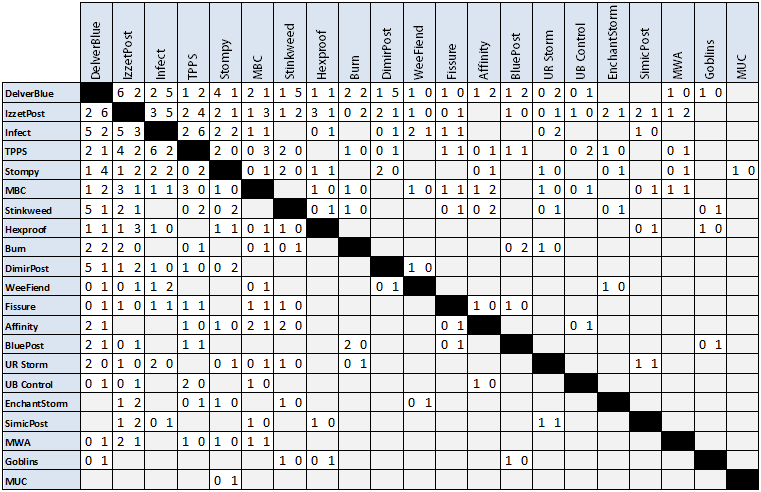
Eliminating outliers, this week’s top performer was a tie between UB Control and Affinity, which managed to win just under 67% of their matches. Unsurprisingly at the other end of the scale, we have Stinkweed Zombies, which managed to only win 38% of its games ending with an overall match record of 8-13. Beyond Stinkweed Zombies, most decks that had a losing record were still relatively close to the 50% mark. Other big contenders included DimirPost, winning 64% of its matches, as well as FissureStorm and UR Storm, which tied at 63% and change. The one deck I’m eliminating from this is MUC, which was ran by only one player who decided to drop after a loss in the first round.
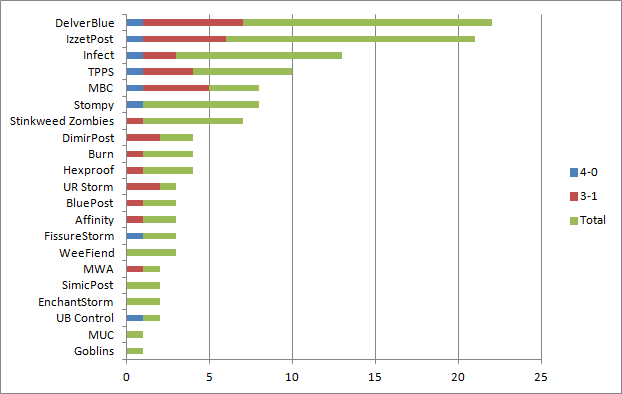
It is unsurprising that in an event with this many people, there were a significant number of winners. Eight players managed to walk away with an undefeated record, and oddly the deck types did not repeat. Beyond that, there were an additional 30 players who ended up with a 3-1 record for a total of 268 packs won in this event. We’re going to finish things up here with a look at a match from this event with BluePost…
SimicPost
In this week’s deck spotlight, we’re going to take a look at an 8-post variant. We’re all too familiar with post decks at this point in time and we’ve seen a small increase in popularity of DimirPost in recent weeks. There is really little to say when it comes to the specific mechanics of how post decks work because it has all been talked to death. We’re all aware of how Cloudpost and Glimmerpost create a significant mana base in order to let players cast spells that would usually be out of range for play due to a high cost. When it comes to post decks, I’m usually relatively hesitant to break them down into specific classifications. Of course things are broken down to include IzzetPost and DimirPost because of their popularity and consistency from week to week. Other classic lists have managed to prove themselves and earn a spot with a specific naming such as BluePost or GreenPost.
Beyond these, we’ve still seen quite a variety of different variations on 8-post. We’ve seen a mono-red variant win as well as GreenPost with a red splash for things like Rolling Thunder. Throughout all of my experiences with 8-post there have been two versions that I’ve personally gotten behind. The first was DimirPost, which I felt interacted better than IzzetPost thanks to access to a variety of kill spells and not having to use a splash for costs in things like Mystical Teachings and Forbidden Alchemy. The only thing the deck really misses out on is that big burn finisher, but this can be compensated through Ulamog’s Crushers or even making red the splash in a similar way that IzzetPost makes black the splash.
The second was SimicPost. I’ve written and discussed 8-post to death with respect to a number of subjects, but since Simic is one of my favorite color combinations it doesn’t take much to understand why it would be one of my favorite 8-post decks. In the early days of this series I put together a SimicPost deck as a bit of a bonus for a discussion on Simic control in Pauper. Shortly afterwards this list would be taken to 3-1 in an event, which was awesome. The deck is in need of updating, but here’s what it looked like…
Control SimicPost by JustSin
|
| ||||||||
The list from today is much different. Most of the times that I’ve seen this deck posting a win it was run by ShaffaWaffa5. Let’s first take a look at the list he runs…
Combo? SimicPost by Shaffawaffa5
|
| ||||||||
As you can see, this deck makes a very interesting new approach to 8-post by bringing in a combo piece. Temporal Fissure is a card that we’ve seen in the familiar and now enchantment-based storm decks in order to tempo-control a game. What we really haven’t seen up until this point is the use of this combo piece alongside the big mana generation of the locus lands. I guess we shouldn’t be too surprised to finally see this happen. The big idea behind storm decks in general is that you need a lot of mana in order to cast a lot of spells. In TPPS and UR Storm it is important to have a really high spell count since Empty the Warrens and Grapeshot are the win condition; however, with Temporal Fissure it is not the win condition and can therefore be effective on a much smaller storm count. What this list is able to do is bring in those low cost spells, which help ramp mana in order to up the spell count, but with the fissure focus it isn’t as critical to drop 15+ spells. The deck can simply storm off 5-6 times to tempo out an opponent and then easily build up to the popular 8-post finishers of Ulamog’s Crusher and Kaervek’s Torch. It’s great to see people continuing to push things and come up with even more creative approaches to different decks.

When it comes to casual Pauper games, there are usually a number of things that may inspire me to head down one path or another. Sometimes it may be seeing someone else in the “Just For Fun” room playing some creative combination, sometimes it may be a new set, but this week it comes from my personal list of cards that really should be getting some love. There are a number of fun cards in Pauper that don’t really see competitive play, but have a relatively high power level. The most popular of these would probably be Blightning, which continues to inspire deckbuilders everywhere to finally make a Rakdos color scheme work. There are so many pet cards out there that every Pauper player loves and wishes could be run at the highest levels of play.
This week’s inspiration comes from the idea of “enters the battlefield” effects. When building a deck in any format, I am always looking for creatures that have cool effects. The triggered effect caused by a creature coming into play easily makes one creature more important than another.
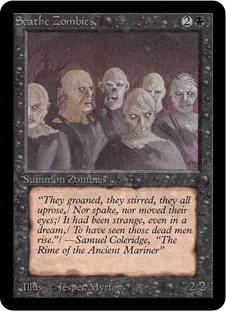
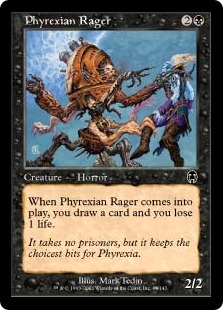
Take a look at these two cards. It is easy to see how the Phyrexian Rager is a stronger card than the Scathe Zombies. As important as a spell would be that says “pay 1 life and draw a card,” it becomes that much stronger by putting it on the body of a Scathe Zombies. This spell now doubles as card draw and an attacker, which is basic card advantage. This means that you have one less spot you need to waste in your 60 card count in order to bring in one spell or the other. It gets even more fun than that because we’ve been granted a number of ways to abuse these abilities.
With the recent release of Innistrad Block, there was a new focus being put on blink abilities. Beyond Pauper we saw Restoration Angel and Conjurer’s Closet, which have provided many ways to abuse enter the battlefield effects. Pauper decks using Momentary Blink have been popular ways of using this and date back to this pretty little Esper number that we still see from time to time…
EsperAggro by Unknown
|
| ||||||||
One of the great things about Momentary Blink was the flashback ability, which would let you run a list like this and get away with the fact that you were only running two copies of the spell. As long as there was no graveyard hate then you’d be able to cast the spell four times while only using up two card slots. We got further blink spells in Innastrad Block thanks to Ghostly Flicker, which we’re all familiar with at this point and how it can be abused alongside return creatures such as Mnemonic Wall and Archaeomancer. We also got a cheaper version of blink minus the flashback ability in Cloudshift, which hasn’t actually seen much in the way of play.
With this particular list, you also get a similar effect thanks to the use of Kor Skyfisher. While it is not an immediate gratification effect, the ability of Kor Skyfisher to return a permenant to your hand allows you that chance to replay a creature and reap the benefits from the “enters the battlefield” effect once again. Kor Skyfisher joined us in Zendikar Block, but it was not the first creature that had the “drawback” of requiring you to return a permanent to your hand in order to make the play. Remember these guys?: Cavern Harpy, Horned Kavu, Lava Zombie, Silver Drake, and Steel Leaf Paladin
One of the things I find myself talking about all the time in this game is the power-to-cost ratio. What is often the tipping point between whether or not a creature is playable comes down to whether the casting cost is favorable in comparison to the size of the creature. Usually the best we can do without any drawbacks is to have a creature with a size equal to that of its casting cost like we see on Runeclaw Bear. If the size of the creature all of a sudden becomes larger than the casting cost required to play it, you’ll find that it has a drawback associated. Basically you’re getting a big creature for cheaper, but there is a price that you have to pay in order to compensate for the difference. Let’s take a look at two classic examples…
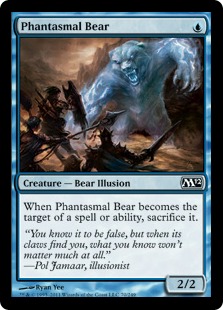
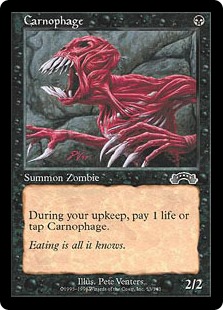
These two creatures can be played for only a single colored mana, but are at a size that is larger than their cost. In the case of Carnophage it has a typical black drawback in that you are required to pay a life each turn in order to allow it to untap so that you can keep swinging with it. Similarly Phantasmal Bear has a typical blue “phantasm” drawback in that if it is simply targeted by a spell, then you are forced to sacrifice it. These drawbacks are compromises that we make in order to play these creatures that are stronger than a Runeclaw Bear because they can be played for cheaper, which helps lower your mana curve.
Enter this cycle of creatures from Planeshift. This goes into a discussion of power creep that I’m not going to go down, but these basically have two drawbacks in order to get access to these creatures with a bigger size than cost. The only exception here would be Steel Leaf Paladin, which is the only one to have a higher cost than power level with no real compensation. The only other ability it has as a “positive” is the first strike, but then why didn’t the fact that Cavern Harpy and Silver Drake have flying make them cost more? Oh well, I guess that, too, is another discussion! The first drawback that these cards have is that the required casting costs are golden. The more mana symbols you have in a spell’s casting cost, the harder it is to play. When those mana symbols are in multiple colors, then the difficultly of casting becomes greater. Cavern Harpy can actually be an important piece in the Aluren decks of eternal formats. What makes the Cavern Harpy more successful there is that they have access to dual lands, which makes that two-colored casting cost more reasonable.
The second drawback that we see on these cards is that you’re required to return a creature to your hand of a color shared with the casting cost. For example, Horned Kavu has a red and green casting cost so it requires you to return a red or green creature to your hand. Simple enough, right? When we sit down and look at cards as we start to build a deck we have to take note of things like this. One of the most important concepts for successful deck building has to do with finding ways to abuse a specific drawback. When we’re challenged with a beast of a creature that has a horrific drawback, then we must rise to that challenge and find ways to get around that (Yea I’m looking at you, Phyrexian Dreadnought). This of course is where our “enters the battlefield” effects come in.
So now we’ve come full circle. We once again are faced with two challenges to making a deck with creatures from this cycle. Our first challenge is going to be dealing with the multiple colors. With the printing of Guildgates we now have access to our own brand of dual lands, but where these fall short is the ability for us to find them. With the use of dual lands like Underground Sea, we can use generic land fetch spells like Farseek in order to fetch an Island and reap the benefits of cheating in two lands at once. In Pauper we currently have only one way to fetch out the guildgates: Gatecreeper Vine. To have access to this, we are then going to be forced into green, which isn’t so bad thanks to Horned Kavu.
The second issue we face is that we want to find a way to abuse the fact that we’re going to be required to return creatures to our hand. Imagine a turn where you’re sitting with four lands and a Gatecreeper Vine in play. You cast a Horned Kavu and use it to return the Gatecreeper Vine, which you then replay. This has created a rather efficient engine for fetching out lands and ensuring that you don’t miss your drops. This brings in many possibilities including the ability to run a third color. Yes, that is right, I’m going to take that leap of faith and work with three colors. It has long been debated on whether or not running more than two colors was a viable thing in Pauper. When the Guildgates were printed, we came closer to being able to achieve that. With the ability to continuously abuse the fetch of Gatecreeper Vine, I’m going to chance the third color. When we look at the Planeshift cycle we have only two choices for creatures that share a color with the Horned Kavu, but the choice is clear. When you compare Lava Zombie and Steel Leaf Paladin, the choice is easy. The cost of the Steel Leaf Paladin would really set our curve off balance and it does not grant us that same level of power in comparison to that heavy cost. So we have our colors… we have our direction… here’s what I put together…
Play Me Again! by JustSin
|
| ||||||||
What I tried to do was bring in a variety of creatures with controlling effects for when they enter the battlefield. We also work to keep our mana cost low so that every creature in the deck can be recovered from the graveyard thanks to Unearth. This, along with the basic bounce ability of the Horned Kavu and Lava Zombie, gives us a chance to get away with not paying the echo costs on our Ghitu Slingers and Stingscourgers. The other quick thing I want to point out is that I wanted to bring in Flame Jab. When testing the deck, I found it did pretty well at ramping up lands, but it really didn’t need to have more than 6-8 lands in play at any point in time. The deck also needed a bit of extra fire power to handle situations where you’ve dumped your hand and need just a little more to finish the game. Flame Jab works well to provide you with those extra spells to finish off creatures and do a little extra damage with all the junk land you may be fetching off of Gatecreeper Vines.
To hear more about what my thoughts were on the deck, check out the videos below, and of course I’ve got some examples of the deck in action as well…
Check me out on Twitter @MTGOJustSin.
Also you can find additional content on my YouTube channel.








Nice deck, seems pretty fun to play with… Probably you can weel 1 or 2 raven’s crime to use all the land you can have with the Gatecreeper Vine?
Another possibility may be to turn into a more aggro deck with wild mongrel and rootwalla?
of cirse just two ideas without testin…
Awesome article, as with all of your previous articles!
As for the decklist, the main problem I see is that the creatures you’ve chosen don’t seem to offer quite enough value for cards like Unearth to be truly awesome (even though I think that card is really good in Pauper). I wish there were some additional synergy there.
Also, I just remembered Arctic Merfolk existed. It’s not good, but it’s interesting in that its ‘gating’ ability involves a cost to cast it, meaning the bounce happens without your opponent’s ability to respond. Not sure how/if that could be relevant.
Nice to see such a unique brew that has teeth! Great design. Raven’s Crime and even one more jab seems warrented.
Great article and cool deck. Fun to see pauper’s own FTK make a list. I really feel that Ghitu Slinger is under-appreciated.
hey guys thanks for the responses!
@ Percif & deluxe: I feel that I made a big mistake in ending this… I didn’t take the time I should have to add a summary of my afterthoughts thinking that they might basically be clear during game play. You both pretty well nailed it, the issue I did find with the deck during these games was flood (oddly in testing it happened pre-Jab, and after testing with the jab for the first few games I was very mana short), I think it really could use, like you guys suggested perhaps another jab or a crime
@ PW (&Percif): something also left out when I really should have added final thoughts…. you’re right the deck was really missing kind of that BIG finish. You look at post decks for example they use Torch or Crusher as a big finish and this deck gets great speed/power off the Kavus and Zombies, but still sometimes found itself relying on burn to finish.. I’d love something like Wild Hunger to finish, but the cost on it is a bit high… actually Howl of the Hungerpack might have brought something to the table making like a visionary stronger mid-game and the deck can get plenty of kills for morbid off of chumping/burn/slinger/etc. Figuring out the finisher could be what moves this out of casual, but I also worry that its a bit slower thanks to the fact that bouncing and creatures are sorcery speed
actually you may be onto something with the merfolk there PW once gatecrash comes out and we get Simic Guildgate and some evolve spells
Sweet deck!
Just a thought though: in g1, wouldn’t it have been quite reasonable to bolt the second disciple to get you out of blast range? Then you could play the zombie to trade with the Enforcer (I mean, so what if it bounces the Kavu which you could replay and bounce the elf). A little less aggressive but safer, it seems to me.
Cheers!
This is great stuff…I know I already said it, but you deserve a second pat on the back. It’s like 3 articles in one. Getting tired of ‘video articles’ personally, nice to see such a great effort.